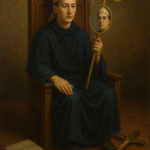ALLEGATIONS: Thanks very much to everyone who wrote in about allegories! Your comments were really helpful. A few very scattered thoughts:
1. It’s very hard for me to think of allegories I’ve actually loved. But The Faerie Queene is phenomenal–I’m addicted to those stanzas, and I’m really glad I read (chunks of) TFQ before becoming Christian. I do think it played a small part in my conversion, insofar as it helped shatter my stereotypes of Christianity and Christian art. TFQ is part of the reason I’ve never really worried if Christianity is conformist (yes, I know this is kind of a crazy perspective, but we live in a kind of crazy age). Its philosophically sophisticated and narratively acute take on what it means to be “imago Dei” has shaped both my philosophy and my fiction, I think. So I can’t accept the proposition that it’s impossible to do allegory in a way that speaks to people today, that has its own beauty, narrative drive, and insight. My post on TFQ is here.
2. One of the things that makes TFQ work might be that its protagonist is not strictly allegorical–the Redcrosse Knight doesn’t “stand for” anything, he’s as much himself as most protagonists are. (I.e. there’s an element in which he stands for every pilgrim soul, but most protagonists are stand-ins in that sense.) Many of the other major characters are either non-allegorical (Arthur) or only partly allegorical (Una, Satyrane). There are many one-to-one correspondences, but also many more shadowed and subtle ways in which characters mirror and refract concepts. Some of the one-to-ones are brilliant–I’m not trying to say that TFQ is a great allegory insofar as it’s not allegorical!–but I do think the narrative thrust and emotional appeal to the reader are best served by not-100%-allegorical characters.
3. David Gurliacci wrote in with some really good quotes from CS Lewis’s “Vision of John Bunyan”:
“There are books which, while didactic in intention, are read with delight by people who do not want their teaching and may not believe that they have anything to teach — works like Lucretius’ “De Rerum Natura” or Burton’s “Anatomy” [I’m using quotes where Lewis italicized] This is the class to which “The Pilgrim’s Progress” belongs. Most of it has been read and re-read by those who were indifferent or hostile to its theology, and even by children who perhaps were hardly aware of it. I say, most of it, for there are some long dialogues where we get bogged down in sheer doctrine, and doctrine, too, of a sort that I find somewhat repellent.
… [S]uch passages are faulty … In them, the speakers step out of the allegorical story altogether. They talk literally and directly about the spiritual life. The great image of the Road disappears. They are in the pulpit. If this is going to happen, why have a story at all? Allegory frustrates itself the moment the author starts doing what could equally well be done in a straigh sermon or treatise. it is a valid form only so long as it is doing what could not be done at all, or done so well, in any other way.“But this fault is rare in Bunyan … The greater part of it [Pilgrim’s Progress] is enthralling narrative or genuinely dramatic dialogue. Bunyan stands with Malory and Trollope as a master of perfect naturalness in the mimesis of ordinary conversation.”
***
“… the pernicious habit of reading allegory as if it were a cryptogram to be translated; as if, having grasped what an image (as we say) ‘means,’ we threw the image away and thought of the ingredient in real life which it represents. But that method leads you continually out of the book back into the conception you started from and would have had without reading it. The right process is the exact reverse. We ought not to be thinking ‘This green valley, where the shepherd boy is singing, represents humility’; we ought to be discovering, as we read, that humility is like that green valley. That way, moving always into the book, not out of it, from the concept to the image, enriches the concept. And that is what allegory is for.”
Thanks again… feel free to write in with more thoughts.











